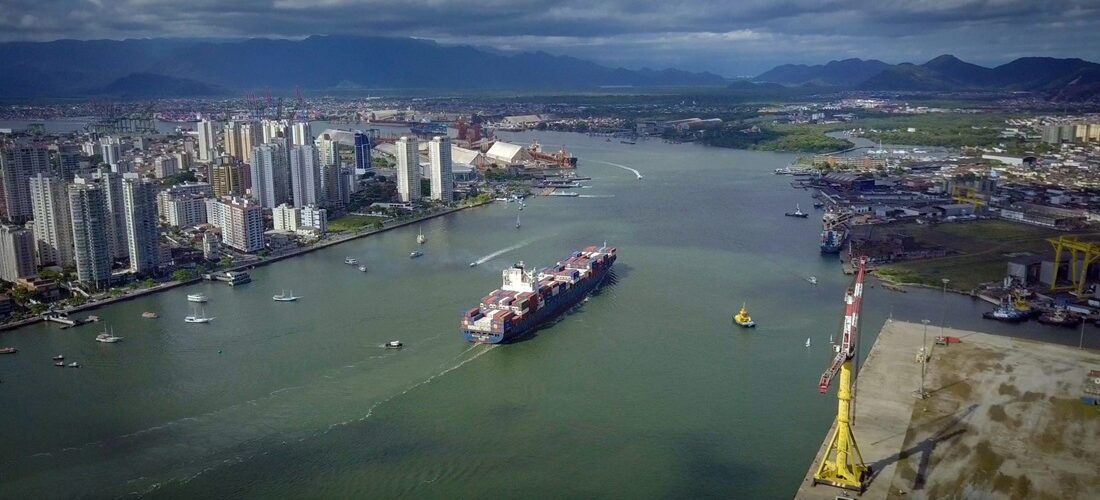
Megaterminal at the Port of Santos Sparks Calls for Competitive Balance—Here’s Why
Mar, 28, 2025 Posted by Denise VileraWeek 202513
The business sector calls for competitive balance in the bidding process to lease the Santos 10 Container Terminal (Tecon Santos 10). Representatives of private entities operating at the Port of Santos are concerned about the practice known as “self-preference,” in which a shipping company prioritizes docking its vessels at its terminal, regardless of the pricing offered by competing terminals.
The executive president of the Brazilian Association of Customs Terminals and Facilities (Abtra), Angelino Caputo, emphasized that the organization demands competitive balance, “at least in the first years of the contract, to prevent independent, white-flag, wet, and hinterland terminals from losing cargo volume below a viable minimum threshold. If shipping lines can operate their terminals without restrictions, self-preference occurs, meaning they can dock exclusively at their facilities without considering price competitiveness. This distorts the market.”
Caputo explained that in 2022, when the first version of the bidding document was drafted, regulatory bodies—including Antaq (National Waterway Transport Agency), Cade (Brazilian Administrative Council for Economic Defense), and the Federal Court of Accounts (TCU)—determined that instead of fully restricting competition or allowing self-preference as a general rule, the implementation of “regulatory remedies” should be considered. These measures would limit cargo movement until market demand grows sufficiently to sustain all terminals and avoid self-preference.
“At the time, Antaq issued a directive suggesting including these regulatory remedies. CEI-ANTAC Dispatch 173-4083 ensures competitive balance during the initial years of the contract, allowing all players to participate,” Caputo noted.
He also stressed the urgency of Tecon Santos 10 but with a key caveat. “We foresee a capacity bottleneck between 2030 and 2032, so the time to launch this bidding process is now to expand the Port of Santos’ capacity. However, we support the auction only if it establishes fair competition and a balanced market.”
The president of the Brazilian Association of Port Terminals (ABTP), Jesualdo Silva, echoed similar concerns. “Our main fear is that self-preference will lead to a market failure. However, since a competitive analysis is being conducted simultaneously to assess the necessity of Antaq and Cade’s regulatory remedies, a new public consultation should be held after its conclusion.”
Silva also raised concerns about logistics. “Regarding road access, while the bidding document requires the concessionaire to build a truck parking lot 50 kilometers away, no technical study has been presented to prove this will be sufficient. ABTP is demanding a technical accessibility study. We don’t want to see traffic congestion in the city. The expectation is that STS 10 will add 4,000 more trucks per day in Santos.”
Leonardo Levy, Director of Investments for the Americas at APM Terminals and a columnist for A Tribuna, highlighted the economic importance of STS 10. “The Ministry is doing a great job. They saw the potential of the Port of Santos, so they decided to auction the terminal as a fully integrated area. This is crucial to ensuring the country’s continued growth. So far, the project has faced multiple hurdles since its inception, delaying it for years.”
See bellow the historical long-haul container movement data at the Port of Santos (excluding cabotage). The data is from DataLiner:
Container Movements from Santos Port JAN 2021- JAN 2025 TEUs
Source: DataLiner (click here to request a demo)
Levy added, “Brazil needs Santos, and the Port Authority must carry out the necessary access infrastructure works. Considering that the future terminal is expected to open between 2030 and 2031, there is more than enough time to address these road access issues.”
Finally, he stressed the need for greater transparency on key aspects of the project, such as cost reductions for transshipment cargo and the environmental licensing timeline. “Twelve months for licensing is entirely unfeasible,” he concluded.
Source: A Tribuna
-
Shipping
Sep, 19, 2022
0
Poland opens canal to Baltic bypassing Russia territory
-
Grains
Oct, 26, 2022
0
Anec exporters association downsizes corn forecast, leaves soybeans untouched
-
Meat
Jan, 19, 2023
0
Indonesia gives greenlight to beef imports; China lifts suspensions, say Brazil’s gov’t
-
Shipping
Sep, 09, 2021
0
CMA CGM makes the decision to stop all spot rate increases

